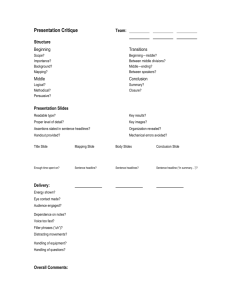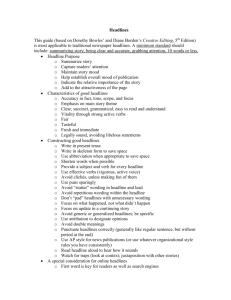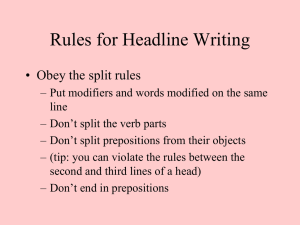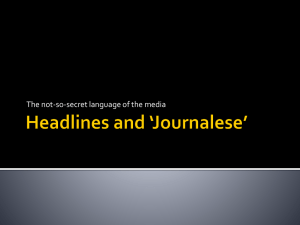Headline & Caption PowerPoint
advertisement
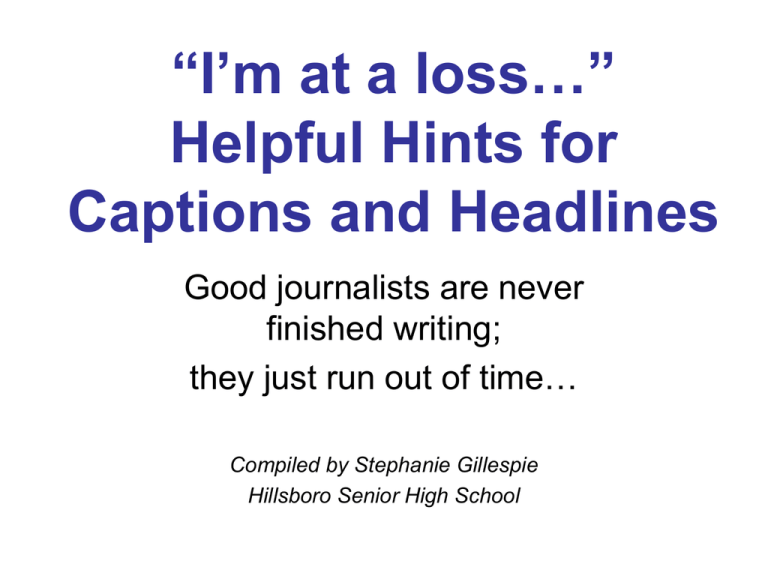
“I’m at a loss…” Helpful Hints for Captions and Headlines Good journalists are never finished writing; they just run out of time… Compiled by Stephanie Gillespie Hillsboro Senior High School Captions • Cute captions don’t cut it. • Always tell more than the obvious. • Position the captions to the outside of the spread and as close as possible to the pictures they identify. • Two captions may be stacked…try not to do any more than that. • Identify all people pictured if possible; identify by first and last name. • Organize your caption so that you don’t always begin with a person’s name. • Never neglect the importance of caption writing. Show your reporting skills by seeking information for the caption that shows you’ve done your job thoroughly. • Supply present tense writing for the action in the photo; write the rest of the caption in past tense. Keep captions interesting • • • • • • WHO? Tailback Mark Law evaded Turner High defenders to snare the game-winning touchdown in the season opener. WHAT? Locking the ball into his hands, Mark Law followed Coach Penrod’s leadership and scored the game-winner against Piper on opening day. WHEN? In the first game of the season, Senior Mark Law set the pace for a league championship with this reception against the Pirates. WHERE? In Tate Stadium, Tailback Mark Law hauled in the first of fifteen touchdown passes that would net him a school record for receptions in a season. WHY? Attempting to set a record for most touchdown receptions, Senior Mark Law hauled in his first against Piper in the home opener. HOW? Catching a pass the hard way helped Tailback Mark Law set a single season scoring record. Law managed to pull down fifteen touchdown passes, including this one against Piper. The ABC of captions A for Action-Packed Information To capture the readers’ attention and make them want to know more about the photograph as well as to establish the relationship between the photo and caption requires an actionpacked caption lead-in. This lead-in is one to three words and can be the actual introductory words for the first sentence of the caption or can be set off as a mini-headline for the caption. Caption writers should avoid stating the obvious and should carefully choose a clever approach and words. B for Basic Information In the first sentence of the caption, the writer should identify the who, what, when, and where of the photograph. This identification/description should be complete answering readers’ questions concerning the action of the photo. Accurate identification using specific names and visual nouns as well as strong, action verbs should reflect extensive reporting by the writer. Write the first sentence in present tense since viewers will experience the photo action simultaneously with caption reading. C for Complementary Information Adding dimension to the caption takes a second (or third), follow-up sentence which supplies readers with the answers to questions not obvious in the photo content. Written in past tense since it presents after-the-fact facts, this part of the caption often focuses on the why and how of the content of the photo and clues readers into the importance of the action to overall coverage. Little-know trivia AND QUOTES, as well as a report of the results of the action of the photograph, finds its place logically in the complementary information. The ABC of captions A for Action-Packed Information Practice with these captions: Rachel Smith, a senior who is on the equestrian team, gently sculpts her ideal horse. Jeanne Lee and Ginger Johnson, juniors, strike their final pose before pom practice ends. Dreaming about Camelot after reading The Sword and the Stone, Sophomore Erin Gannon falls asleep in Mrs. Pat Dunn’s English class. Before the baseball game, pitcher Brian Wolfe practices his famous curve ball which has made him a dominant force on the team. While bumping the ball to freshman Maxine Earnest, Freshman Kerrie Rilley pushes herself to the limit. B for Basic Information C for Complementary Information Story captions or scatterstories are extended captions that replace regular stories. • Apply the same ABC method, but add more details in the complementary information. • The most popular way to extend the story is by adding quotes from those involved. Let the student or teacher take a turn telling the story in her own words. • This “short story” becomes about the photo rather than trying to write a complete “story of the year” piece that becomes predictable and boring. 10 Ways to Write Caption Leads Varying your lead is the key to good caption writing. Note the many ways to write the same facts in the examples following. 1. An Adjective Lead begins with an adjective word or phrase describing the subject of the copy. Adjective leads provide color and descriptive appeal. EXAMPLE: Sweets, both M&Ms and appreciative looks, leave John Marsh as he sells another box of candy to Julie Jones, a sophomore in his trigonometry class. 10 Ways to Write Caption Leads 2. An Adverb Lead begins with an adverb or adverbial phrase or clause. Adverb leads provide active description in the first few words. EXAMPLE: Rarely seen without his M&Ms, John Marsh, a trumpet player, sells Julie Jones candy to munch on in her fourthperiod English class. Band members raised $3000 selling candy to finance their February trip to New Orleans to march in the Mardi Gras parade. 10 Ways to Write Caption Leads 3. A Causal Lead emphasizes the reason or cause of the action and begins with such words as “because” or “since.” EXAMPLE: Because money was scarce and buses were expensive, band members sold 4,200 boxes of M&Ms to finance their February trip to Mardi Gras. Contributing to the cause, Julie Jones buys her seventh box of chocolate-covered peanuts from top salesperson John Marsh. 10 Ways to Write Caption Leads 4. A Gerund Lead begins with a verb ending in “ing” in a noun-like form. Use gerund leads sparingly. EXAMPLE: Raising money for the band trip to New Orleans was a between-class activity for the 175 band members. John Marsh, top salesperson in the campaign and first-chair trumpet player, sells M&Ms to Julie Jones, who said she was a regular customer supporting the cause with her purchases. 10 Ways to Write Caption Leads 5. An Infinitive Lead uses a verb form along with “to.” Infinitive leads provide action at the beginning of the copy. EXAMPLE: To charter buses to New Orleans, band members sold M&Ms. Trumpet player John Marsh sells Julie Jones one of the 4,200 boxes of candy that helped send the 175-member band to the February Mardi-Gras parades. 10 Ways to Write Caption Leads 6. A Participle Lead begins with a verb ending in “ing” or “ed” in an adjective phrase. It can incorporate both action and description in the first word. Use this type sparingly. EXAMPLE: Selling another box of M&Ms, John Marsh, first-chair trumpet player, reaches his goal of top salesperson in the band’s candy campaign as he sells another box to Julie Jones. 10 Ways to Write Caption Leads 7. A Prepositional Lead begins with a prepositional phrase and provides description. EXAMPLE: With M&Ms in hand and New Orleans in mind, trumpet player John Marsh sells a sweet treat to Julie Jones, a sophomore in his Trig class. Candy sales financed the band’s February trip to Mardi Gras. 10 Ways to Write Caption Leads 8. A Proper Noun Lead begins with a proper noun or name when that person or thing is the most important part of the story. Because proper noun leads don’t imply action, use them sparingly. EXAMPLE: John Marsh, who has been in band for three years, sells the seventh box of M&Ms to Julie Jones, a sophomore in his Trig class. The class sale of candy was one of the most popular ways of raising money; 32 different groups sold 11 types of candy during the year. 10 Ways to Write Caption Leads 9. A Temporal Lead features a time element and often begins with “while,” “where,” “as,” or “since.” EXAMPLE: While some band members work hard to sell their M&Ms, top saleperson John Marsh makes it look easy with over 300 sales. Julie Jones buys her seventh box, one of the 4,200 sold to finance the band’s trip to march in the Mardi Gras parade. 10 Ways to Write Caption Leads 10. A Quotation Lead begins with a quote from the subject of the picture. It is good only if WHAT was said is more important than anything else. EXAMPLE: “My skin may break out, and I may get a stomachache before I go, but the trip to New Orleans will be worth it,” said John Marsh, first-chair trumpet player. The band’s trip to Mardi Gras was funded by the sale of 4,200 boxes of M&Ms. A frequent customer, Julie Jones, buys another box from Marsh. The interview leads to good caption writing. Without a solid interview, you have NOTHING to write about. • Before writing anything, it all starts with a detailed interview that has been prepared in advance. • During the interview, ask follow-up questions and write down information accurately. • After the interview, ask the person to reread the statements to verify accuracy, and then have the person sign the interview. The photo log leads to a good interview. • Before taking a picture, note the who, what, where, when of the event. • During the event, write down information accurately about the details of the event including the action before and after the photo was taken. • After the event, follow up by deleting blurry or unusable photos and crossing them off on the log. Let’s talk headlines • Leave space for headline design when templates are made. • Publicly display some fonts to be used in headlines to maintain section consistency. • Allow variations in design and font in order to have the best headline possible. • Wait until the page is nearly finished to write and design the headline. Let’s talk headlines A top 10 guide to writing good headlines • Write in the present tense. Use active verbs. • Put the key words of the story in the main head. • Get the most important story element in the headline. Headlines should tell readers what happened and why the news is important to readers. • Avoid puns, but be clever. • Be accurate. • Be interesting and inviting. Headlines should be an advertisement for the story, but they should never be so cute that they fail to instantly tell the news. • Be creative. Headlines can and should creatively convey a mood or emotion when appropriate, but they must always tell the news in clear and direct fashion. • Don't pirate the lead of the story or give away the ending. Stealing the lead means repeating it almost verbatim. You do want to make sure the headline matches the tone of the story. • Rarely (almost never) use short, verb-less labels as main heads for news stories. They fail to tell the news. • Avoid headlinese. Make headlines conversational. By Sue Burzynski of The Detroit News for “No Train, No Gain” on the web. Headlines: Words have power • Headlines are like poetry. Every word must be more powerful since there are so few words. • Headlines must be researched in two ways: 1. old yearbooks to avoid duplicating headlines from previous years and 2. the internet or other resources to come up with a word bank of powerful, visual words that pertain to the subject. Headlines: Words have power • Try www.merriamwebster.com/thesaurus to find synonyms, antonyms, and related words. The simple format is direct and easy-to-follow. • The related words are probably going to be the most useful for writing headlines. • Another great resource is www.thesaurus.com. Headlines: Words have power • Now is the time to use all of those poetic devices you learned in English class through the years. • Techniques like alliteration, assonance, onomatopoeia, rhyme, simile, metaphor, imagery, and personification should be used. • Consider “verbing” words to come up with fresh phrasing. • Be aware of potential double-meanings in headlines. • Make accuracy your number one priority, followed by creativity. Headlines: Words have power Use the TACT Test: Taste-Attractiveness-Clarity-Truth (Ask these questions of each headline): 1. Is it in good taste? Anything offensive in any way? Can anything be taken a wrong way? 2. Does it attract the reader's attention? How can it be improved without sacrificing accuracy? 3. Does it communicate clearly, quickly? Any confusion? Any odd words, double meanings? 4. Is it accurate, true? Proper words used? Is the thrust of subject-verb true? 5. A single "NO" above is a veto. One "No" vote represents thousands of readers. Start over: rethink the headline from the beginning. From “No Train, No Gain: Training for Newspaper Journalists” at http://www.notrainnogain.org/train/res/copyd/man.asp Headlines: Design gives powerful words the spotlight • Make important words stand out in size, font, and/or color. • Most designs should have no more than two or three fonts. • Keep unimportant words like “an, an, the, of,” etc. in the background. • DO NOT capitalize every word in the headline. For the most part, headlines should read like sentences and include a verb. If the main part of the headline doesn’t have a verb, add a sub-headline that does have a verb. Headlines: Design shines a spotlight Headlines: Design shines a spotlight Headlines: Design shines a spotlight Headlines: Design shines a spotlight Headlines: Design shines a spotlight Headlines: Design shines a spotlight Headlines: Design shines a spotlight Headlines: Design shines a spotlight Headlines: Design shines a spotlight Headlines: Design shines a spotlight Headlines: Design shines a spotlight Headlines: Design shines a spotlight Headlines: Design shines a spotlight Headlines: Design shines a spotlight Headlines: Design shines a spotlight
